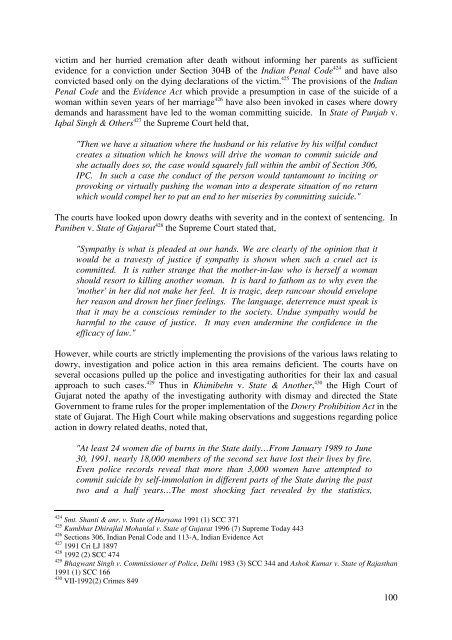SEXUAL HEALTH AND HUMAN RIGHTS A legal and ... - The ICHRP
SEXUAL HEALTH AND HUMAN RIGHTS A legal and ... - The ICHRP
SEXUAL HEALTH AND HUMAN RIGHTS A legal and ... - The ICHRP
You also want an ePaper? Increase the reach of your titles
YUMPU automatically turns print PDFs into web optimized ePapers that Google loves.
victim <strong>and</strong> her hurried cremation after death without informing her parents as sufficient<br />
evidence for a conviction under Section 304B of the Indian Penal Code 424 <strong>and</strong> have also<br />
convicted based only on the dying declarations of the victim. 425 <strong>The</strong> provisions of the Indian<br />
Penal Code <strong>and</strong> the Evidence Act which provide a presumption in case of the suicide of a<br />
woman within seven years of her marriage 426 have also been invoked in cases where dowry<br />
dem<strong>and</strong>s <strong>and</strong> harassment have led to the woman committing suicide. In State of Punjab v.<br />
Iqbal Singh & Others 427 the Supreme Court held that,<br />
"<strong>The</strong>n we have a situation where the husb<strong>and</strong> or his relative by his wilful conduct<br />
creates a situation which he knows will drive the woman to commit suicide <strong>and</strong><br />
she actually does so, the case would squarely fall within the ambit of Section 306,<br />
IPC. In such a case the conduct of the person would tantamount to inciting or<br />
provoking or virtually pushing the woman into a desperate situation of no return<br />
which would compel her to put an end to her miseries by committing suicide."<br />
<strong>The</strong> courts have looked upon dowry deaths with severity <strong>and</strong> in the context of sentencing. In<br />
Paniben v. State of Gujarat 428 the Supreme Court stated that,<br />
"Sympathy is what is pleaded at our h<strong>and</strong>s. We are clearly of the opinion that it<br />
would be a travesty of justice if sympathy is shown when such a cruel act is<br />
committed. It is rather strange that the mother-in-law who is herself a woman<br />
should resort to killing another woman. It is hard to fathom as to why even the<br />
'mother' in her did not make her feel. It is tragic, deep rancour should envelope<br />
her reason <strong>and</strong> drown her finer feelings. <strong>The</strong> language, deterrence must speak is<br />
that it may be a conscious reminder to the society. Undue sympathy would be<br />
harmful to the cause of justice. It may even undermine the confidence in the<br />
efficacy of law."<br />
However, while courts are strictly implementing the provisions of the various laws relating to<br />
dowry, investigation <strong>and</strong> police action in this area remains deficient. <strong>The</strong> courts have on<br />
several occasions pulled up the police <strong>and</strong> investigating authorities for their lax <strong>and</strong> casual<br />
approach to such cases. 429 Thus in Khimibehn v. State & Another, 430 the High Court of<br />
Gujarat noted the apathy of the investigating authority with dismay <strong>and</strong> directed the State<br />
Government to frame rules for the proper implementation of the Dowry Prohibition Act in the<br />
state of Gujarat. <strong>The</strong> High Court while making observations <strong>and</strong> suggestions regarding police<br />
action in dowry related deaths, noted that,<br />
"At least 24 women die of burns in the State daily…From January 1989 to June<br />
30, 1991, nearly 18,000 members of the second sex have lost their lives by fire.<br />
Even police records reveal that more than 3,000 women have attempted to<br />
commit suicide by self-immolation in different parts of the State during the past<br />
two <strong>and</strong> a half years…<strong>The</strong> most shocking fact revealed by the statistics,<br />
424 Smt. Shanti & anr. v. State of Haryana 1991 (1) SCC 371<br />
425 Kumbhar Dhirajlal Mohanlal v. State of Gujarat 1996 (7) Supreme Today 443<br />
426 Sections 306, Indian Penal Code <strong>and</strong> 113-A, Indian Evidence Act<br />
427 1991 Cri LJ 1897<br />
428 1992 (2) SCC 474<br />
429 Bhagwant Singh v. Commissioner of Police, Delhi 1983 (3) SCC 344 <strong>and</strong> Ashok Kumar v. State of Rajasthan<br />
1991 (1) SCC 166<br />
430 VII-1992(2) Crimes 849<br />
100

















